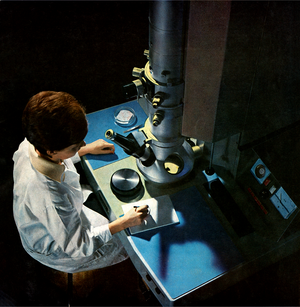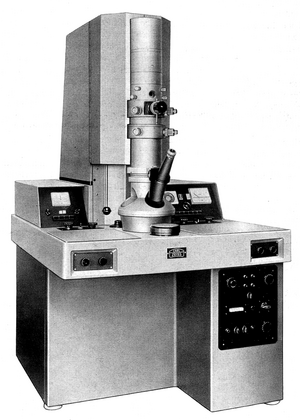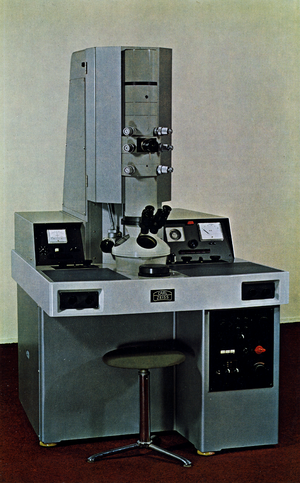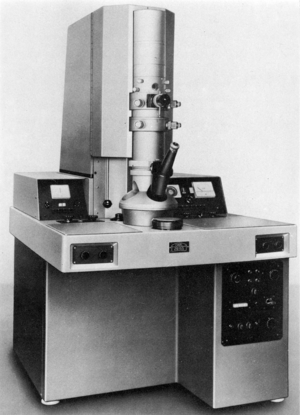Difference between revisions of "EM9"
(→EM9S2) |
|||
| Line 35: | Line 35: | ||
<div style="clear: both"> | <div style="clear: both"> | ||
== EM9S2 == | == EM9S2 == | ||
| − | + | The EM9S2 appears to be the successor of the EM9A, also featuring a single stage Condenser like that seen in the EM9A. Currently the technical differences between the EM9A and EM9S2 are unknown to the author. | |
</div> | </div> | ||
</div> | </div> | ||
<div style="clear: both"> | <div style="clear: both"> | ||
| + | |||
| + | [[Category:Zeiss]] | ||
| + | |||
= Documentation = | = Documentation = | ||
{{#tree: | {{#tree: | ||
Revision as of 13:20, 19 October 2021
The EM9 was Carl Zeiss first Electromagnetic focusing TEM. It was later Succeeded by the EM10 series. Its design Philosophy was to create an affordable and easy to use Electron Microscope which can be operated by the average scientist with little problems. This came at the cost of the ultimate Resolution these machines could attain in routine Operation.
At the time of its creation, two general types of Operation Philosophy and Operator had started to become apparent to the Manufacturers. These are the High performance instruments, for which no expense and complexity was spared in the pursuit of resolution. This usually resulted in an instrument whose Operation required at the very least some knowledge of Physics, as well as being vigilant so as to not place the instrument into a state where it may suffer damage. Additionally, most things that could be adjusted within the microscope, where available for such, to the user. Some of these adjustments, such as Lens Alignment and Tilt correction tended to result in poorer ultimate resolution, if attempted by an unexperienced user, or done in haste. Thus the ultimate resolving power was down to user Knowledge, Experience and Skill.
The other type of Operation Philosophy and Operator was that observed in the creation of the EM9, this is the Scientist who uses the Electron Microscope merely as a tool to further his research. Thus operating the instrument was intentionally made simpler, blocking many delicate adjustments to the normal user, and generally ensuring a decent performance throughout its magnification range. Instruments of this type where also usually cheaper then the high performance units mentioned above, with the added benefit of having the user not having to worry as much about making a mistake when operating the instrument. This greatly Interesses, according to various sources (see promotional brochures under the section documentation), the efficient use of the microscope for routine tasks.
Their vacuum systems and safeguards are also designed so that not much user error can lead to damage to the microscope, though it is still possible to produce valve states which can and will damage the system. Examples of these are the venting of the Diffusion pump to air and or the Column.
Much like its predecessor, the EM8, this unit also features vacuum tube based circuitry as well as a High Frequency AC based High Voltage system. Also, much like its predecessor, the machine was designed to have minimal external components cluttering the lab in which it is set up. The only external component which is not the Microscope proper, is its Roughing Vacuum pumps.
Variants
4 Variants of the EM9 are currently known to the author, these are the original EM9 as seen in the first image and promotional picture above. As well as the EM9A, EM9S and EM9S2. It is currently unknown what the differences between the EM9S and EM9S2 are. Furthermore based on the images provided, the EM9 and EM9S appear to be the same machine, but with a different name, what was changed between these 2 version is thus unkown.
EM9
This is the first generation of EM9, unlike later versions, it did not feature a condensor lens, instead opting for the use of direct illumination by the electron gun.
EM9A
This the second generation of the EM9, now featuring a 1 stage magnetic condensor lens.
EM9S
The EM9S appears, based on the image from Meeks book "Practical Electron Miroscopy for the Biologist, First Edition" to be externally nearly identical to the earlier EM9
EM9S2
The EM9S2 appears to be the successor of the EM9A, also featuring a single stage Condenser like that seen in the EM9A. Currently the technical differences between the EM9A and EM9S2 are unknown to the author.
Documentation



